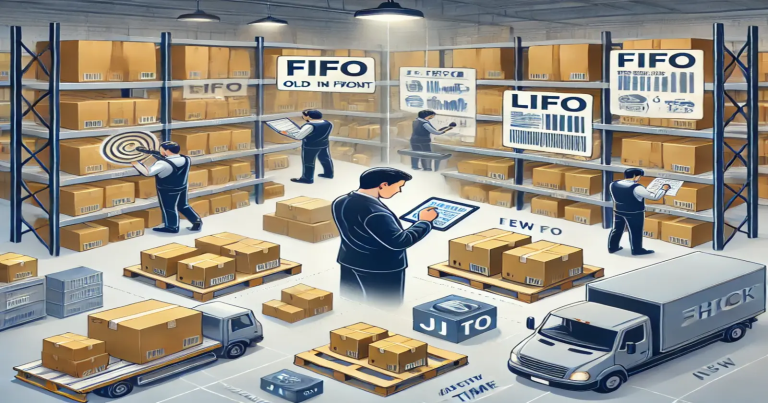Every business that sells products must manage its stock. If it has too much inventory, money gets stuck. If it has too little, customers don’t get their orders. This is where inventory control methods help. They guide businesses on how to keep the right amount of stock—no more, no less.Inventory control methods are tools and systems. They help businesses track how much stock they have. They also help in planning what to order, when to order, and how much to order. These methods ensure smooth flow of goods. They also stop overstocking and stockouts. Big companies like Amazon, Flipkart, and Reliance Retail use them. Small shops and online sellers also use them to save cost and increase profit.
What is Inventory Control?
Inventory control means managing stock properly. It helps you know how much you have, how much you need, and how much you must buy.You may have raw materials, finished goods, or spare parts. Inventory control tracks all of them. It avoids wastage, reduces storage costs, and meets customer demand on time.
Features of Inventory Control
- Tracks products from purchase to sale.
- Keeps record of all goods in storage.
- Helps reorder goods before they finish.
- Saves money and storage space.
Example
Let’s say a shop has 100 shirts. If it sells 10 per day, it needs to reorder in 7 days. If it does not track sales, it might order too late and lose sales.
That’s why inventory control matters. It acts like a watchman who keeps an eye on the goods.
What are Inventory Control Systems?
Every business that sells or stores goods must choose the right system to control its inventory. Two major systems used around the world are the Periodic Inventory System and the Perpetual Inventory System. Both systems help in tracking stock, but they work in different ways. Businesses choose them based on their size, type, and budget.
- Periodic Inventory System : The Periodic Inventory System is a method where businesses update inventory records only at fixed time intervals. This means the stock is not updated after every sale or purchase. Instead, it is updated weekly, monthly, or quarterly.
- Perpetual Inventory System : The Perpetual Inventory System updates stock records in real time. Every time a sale or purchase happens, the system updates inventory data instantly.It uses barcode scanners, inventory management software, and POS (Point of Sale) systems. Large retail chains, warehouses, and e-commerce sites use this system.
What are Inventory Control Methods?
Inventory control methods are techniques used to manage stock. They help decide how much to order, when to order, and how often to order.These methods improve planning, reduce waste, and save money.
First-In, First-Out (FIFO)
The FIFO method stands for First-In, First-Out. This means that the oldest stock is sold or used first before the new stock. It is the most commonly used method for goods that can expire, like food, medicine, or dairy products. FIFO helps reduce waste and maintain freshness. By using FIFO, businesses also keep their inventory flow smooth and orderly. It reflects more accurate stock valuation, especially when prices are rising, because older and usually cheaper items are sold first, leaving the newer and more expensive ones in stock.
Last-In, First-Out (LIFO)
The LIFO method means Last-In, First-Out. In this method, the most recently purchased stock is sold or used first. LIFO works well for products that do not spoil quickly, such as raw materials, metals, and construction goods. This method can be helpful during inflation because it matches higher current costs with sales, resulting in lower taxable income. However, this method is not accepted under IFRS, which means international companies cannot use it, although it is still permitted under US GAAP. LIFO is mainly used in regions or industries where it is allowed and makes financial sense.
Just-In-Time (JIT)
Just-In-Time is a method that focuses on keeping inventory as low as possible. Businesses only order stock when they need it, not before. This reduces the cost of storage and lowers the risk of waste or theft. JIT is useful for companies that have good suppliers who deliver on time. For example, car companies use JIT to receive parts exactly when they are needed on the production line. However, this method also carries risks. If there is any delay from the supplier, the business may not be able to meet customer demand. So, JIT needs careful planning and strong supply chain partnerships.
Economic Order Quantity (EOQ)
EOQ is a mathematical formula used to find the ideal order quantity that minimizes both ordering and holding costs. This method helps businesses figure out the right amount of stock to buy at one time. If a company orders too often, it spends more on processing orders. If it orders too much, it spends more on storage. EOQ gives a balance point where total inventory cost is the lowest. This method works best when demand is steady and costs like ordering charges and storage expenses are easy to estimate. It gives businesses a clear way to save money and avoid unnecessary orders.
Formula:
| EOQ = √(2 x Demand x Ordering Cost / Holding Cost) |
ABC Analysis
ABC Analysis is a method used to classify inventory into three categories based on their value and importance. ‘A’ items are high-value products that are sold less frequently but contribute the most to profit. ‘B’ items are medium-value products, while ‘C’ items are low-value items sold in high volume. This method helps businesses give more attention to managing A items properly, as they affect profit the most. It also helps reduce focus on less important items that don’t need tight control. ABC Analysis is helpful in identifying which stock needs careful tracking and which can be ordered in bulk without much risk.
Reorder Point System
The reorder point system is a simple method where a business sets a minimum level for each product in stock. When the quantity reaches that level, it signals the need to reorder. This method helps avoid stockouts and keeps the business running without interruptions. It works well with both manual and automated inventory systems. Reorder points can be set based on past sales data, average delivery times, and how fast the product sells. This method ensures that orders are made at the right time, avoiding both delays and overstocking.
Importance of Inventory Control Methods
Inventory control methods help businesses manage stock in the best way possible. They make sure you never have too much or too little stock. These methods give you a plan. They guide you on when to order, how much to order, and how to store it. This keeps your business smooth, your customers happy, and your profits growing.
- Helps to Prevent Stockouts: One big reason to use inventory control methods is to avoid stockouts. A stockout happens when a business runs out of a product that customers want to buy. This is bad because the customer will go to another shop and may not come back. With the right methods like Just-In-Time or Economic Order Quantity, the business can order new stock before it finishes. This way, the shop always has what customers need, and no sale is lost due to missing products.
- Reduces Extra Stock or Overstocking: Keeping too many items in the store is also a problem. It takes up space and costs money to store. Sometimes, the products get old, spoiled, or broken. When a business uses methods like ABC analysis or FIFO, it only keeps the products that sell fast. It also sells the older stock first, which reduces waste. By avoiding extra stock, the business saves money and keeps the storage area clean and useful.
- Lowers Storage and Holding Costs: A store or warehouse needs space, lights, and staff to keep the stock. These are called storage or holding costs. If a business stores more items than needed, the cost goes up. When inventory control methods are used properly, the business stores only what it needs. For example, Just-In-Time ordering helps reduce the amount of stock kept. This lowers electricity bills, rent, and the number of workers needed in the store.
- Makes Cash Flow Better : When a business buys stock, it spends money. If the stock is not sold quickly, the money stays stuck. The business cannot use this money for other things. With good inventory control, the business orders just enough products and sells them fast. This means the money comes back quickly, and the business can use it again. This keeps the business strong and safe from money problems.
- Increases Customer Happiness: When customers come to a shop, they want to find the products they need. If the product is not there, they feel unhappy and may go to another shop. If this happens many times, the customer may never return. But if a shop always has the right products, the customer becomes happy and stays loyal. Inventory control methods help the business keep the right items in stock. This makes the customer feel valued and respected.
- Helps to Predict Future Sales: Some inventory control methods also help the business know what items will sell more in the future. They look at old sales data and help the business prepare for the busy seasons. For example, in summer, coolers and cold drinks sell more. If the business uses inventory planning methods, it can order these products early and meet the high demand. This avoids last-minute problems and increases profits during peak seasons.
- Supports Business Growth: When a business has control over its stock, it runs smoothly. The owner has more time and money to think about new ideas and growth. The business can open more branches or add new products. Because stock problems are already managed, the business can grow without fear. Inventory control gives the business a strong base for bigger success.
- Reduces Mistakes and Theft: If stock is not managed properly, workers may make mistakes. Some items may be lost, damaged, or even stolen. When inventory control systems are in place, every product is tracked. This makes it easy to see if something is missing. If something goes wrong, the business can fix it quickly. This keeps the store honest, clean, and organized.
- Builds Strong Supplier Relationships: Suppliers like to work with businesses that order regularly and correctly. When a business uses inventory control methods, it orders the right quantity at the right time. This builds trust with suppliers. They may offer discounts or fast delivery. This also helps the business get better deals and stay ahead of the competition.
Relevance to ACCA Syllabus
Inventory control methods are crucial in the ACCA syllabus under papers such as MA (Management Accounting) and PM (Performance Management). These methods affect stock valuation, costing systems, budgeting, and financial reporting. A good understanding of FIFO, LIFO, and inventory cost control helps in cost analysis and decision-making tasks.
ACCA Inventory Control Methods Questions
Q1: Which inventory method is most likely to reflect the most recent cost in the cost of goods sold?
A) FIFO
B) LIFO
C) EOQ
D) JIT
Ans: B) LIFO
Q2: What is the main objective of Economic Order Quantity (EOQ)?
A) Maximize production
B) Minimize order processing time
C) Minimize total inventory costs
D) Increase customer demand
Ans: C) Minimize total inventory costs
Q3: In ABC analysis, what does ‘A’ category typically represent?
A) High quantity, low value items
B) Randomly used items
C) High value, low quantity items
D) Items with short shelf life
Ans: C) High value, low quantity items
Q4: Which inventory method focuses on reducing holding cost by receiving goods only when needed?
A) FIFO
B) LIFO
C) JIT
D) Weighted Average
Ans: C) JIT
Relevance to US CMA Syllabus
Inventory control is central to Part 1 of the CMA syllabus (Financial Planning, Performance, and Analytics). Understanding inventory costing methods, variance analysis, and cost behavior is necessary for performance evaluation and internal decision-making.
US CMA Inventory Control Methods Questions
Q1: Which of the following inventory control methods helps reduce carrying cost by lowering inventory levels?
A) Perpetual System
B) Just-In-Time (JIT)
C) FIFO
D) LIFO
Ans: B) Just-In-Time (JIT)
Q2: In a manufacturing company, which inventory method best suits high-volume, low-value items for regular use?
A) ABC Analysis
B) EOQ
C) LIFO
D) JIT
Ans: A) ABC Analysis
Q3: What is the core benefit of using a perpetual inventory system?
A) Requires no record-keeping
B) Allows bulk ordering discounts
C) Provides real-time stock data
D) Uses physical stock counts monthly
Ans: C) Provides real-time stock data
Q4: If a firm aims to balance ordering costs and holding costs, which method should be applied?
A) LIFO
B) FIFO
C) EOQ
D) ABC
Ans: C) EOQ
Relevance to US CPA Syllabus
For CPA candidates, inventory control is covered under the FAR (Financial Accounting and Reporting) and BEC (Business Environment and Concepts) sections. It includes accounting treatments, costing methods, and the impact of inventory on financial statements and tax implications.
US CPA Inventory Control Methods Questions
Q1: Under U.S. GAAP, which inventory method is allowed for tax purposes but not under IFRS?
A) FIFO
B) Weighted Average
C) LIFO
D) Specific Identification
Ans: C) LIFO
Q2: What does the FIFO method assume about the flow of inventory?
A) Newest goods sold first
B) Oldest goods sold first
C) Goods sold in random order
D) Goods with highest cost sold first
Ans: B) Oldest goods sold first
Q3: When inventory prices are rising, which method results in the highest reported net income?
A) LIFO
B) FIFO
C) JIT
D) EOQ
Ans: B) FIFO
Q4: Which inventory control technique is used to categorize inventory based on value and usage?
A) Weighted Average
B) ABC Analysis
C) JIT
D) EOQ
Ans: B) ABC Analysis
Relevance to CFA Syllabus
In the CFA Level 1 and 2 syllabi, inventory management appears in Financial Reporting and Analysis (FRA) and Portfolio Management. Understanding FIFO, LIFO, and inventory valuation helps in interpreting financial statements and analyzing profitability.
CFA Inventory Control Methods Questions
Q1: Under IFRS, which of the following inventory valuation methods is not allowed?
A) FIFO
B) Weighted Average
C) Specific Identification
D) LIFO
Ans: D) LIFO
Q2: When prices are falling, which inventory method leads to lower COGS and higher net income?
A) FIFO
B) LIFO
C) Weighted Average
D) JIT
Ans: B) LIFO
Q3: Which method is used to minimize inventory waste and improve efficiency in production planning?
A) EOQ
B) JIT
C) LIFO
D) Perpetual
Ans: B) JIT
Q4: Why is ABC analysis useful for portfolio or inventory managers?
A) It speeds up production
B) It identifies high-risk assets
C) It focuses on important inventory items
D) It improves tax reporting
Ans: C) It focuses on important inventory items


